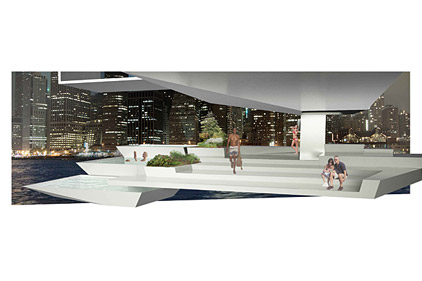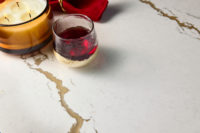Cosentino, a world leader in quartz, natural stone and recycled surfaces, announced the launch of Dekton by Cosentino, a new ultra-compact surface with advanced technical properties for both interior and exterior design. The U.S. launch recently took place with a press conference and exhibition opening at the Center for Architecture, in conjunction with Archtober, a month-long festival celebrating architecture and design in New York City.
The exhibition, Surface Innovation: Redefining Boundaries of Interior and Exterior Spaces, showcased the rigorous research, development and innovation led by Cosentino to bring Dekton to market and featured original concepts by six emerging New York architecture firms, including Architecture in Formation, Desai/Chia Architecture, Easton+Combs, Manifold Architecture Studio, Moorhead & Moorhead and SOFTlab. Known for their innovation and creative approaches, these future leaders of the industry presented six diverse design concepts using the new Dekton material -- showing new ways to think about surfaces and the relationship between interior and exterior spaces.
"Cosentino is passionate about innovation, and Dekton represents an important evolution in the surfacing category," said Eduardo Cosentino, CEO of Cosentino North America. "It was a natural alliance to work with firms who are pushing the envelope to help shape the future of the industry. This exhibition brings together the creative energies of some of the most talented young architects in New York."
Juxtaposing emerging design with world-renowned architecture, the press conference was attended by prestigious architect Daniel Libeskind who announced he is working with the new Dekton material to create Beyond the Wall, a permanent sculpture at the Cosentino global headquarters in Spain. Beyond the Wall shows Libeskind's unique approach to architecture as a language capable of narrating the story of the human soul; a hybrid and wide-ranging force, at once a narrative, a method, an art form and a way of thinking about the world. Dekton is the deep skin of this amazing concept. The project is to be unveiled by Libeskind in Spain in late November 2013.
About Dekton
Dekton is the most significant new product launch for Cosentino in over a decade -- totaling more than 22,000 hours of research and development. Cosentino has invested $172 million into the new product, including the construction of a new state-of-the-art factory at the company's manufacturing headquarters in Spain. Dekton is made from a blend of raw materials used in the production of refined glass, porcelain and natural quartz, and utilizes a proprietary new advancement called Particle Sintering Technology (PST), developed exclusively by Cosentino's Research & Development (R&D) team.
PST is essentially an accelerated version of the metamorphic rock formation process that occurs in nature, where rock is subjected to intense heat and pressure over thousands of years. To manufacture Dekton, Cosentino has reduced this process to four hours with extreme heat and pressure. The result is an ultra-compact surface with unique UV resistance, exceptional strength and performance, high resistance to impact, scratches and abrasion for use in high-traffic areas and has very low water absorption. It also provides thermal shock resistance against heat, frost and thawing, enabling the product to be used outside in any climate. This powerful combination allows Dekton to be used in multiple architectural applications, including flooring, cladding, staircases, exterior facades, kitchen countertops, bathrooms, pool surrounds and many other home and commercial surfaces. For architects and designers, Dekton harnesses the potential for design to flow from the indoors to outdoor spaces using one continuous product, creating complete uniformity.
"The introduction of Dekton by Cosentino today is the culmination of years of R&D and our unwavering commitment to innovation in order to remain at the forefront of our industry," said Lorenzo Marquez, Vice President of Marketing at Cosentino North America. "We are thrilled to present it to the U.S. market during Archtober and in partnership with such an incredible group of talented architects."
The exhibition was presented by Cosentino in collaboration with AIA New York. (CLICK TO ENLARGE PHOTOS)
The Dekton Living Ribbon-The Poly-Performing Mono-Material
Architect: Matthew Bremer, AIA, Architecture In Formation
Architect's Description: Dekton is a surfacing material that hyper-performs across an array of uses and applications.
Remarkably resistant to fire, heat, abrasion, impact, staining, thermal expansion, thermal shock and UV fading, Dekton can be deployed throughout a range of interior and exterior surfaces -- the extent to which we can only begin to ponder within the framework of this exhibition. This leaves open a rich possibility for future product and program development.

As such, we have allowed ourselves to imagine The Dekton Living Ribbon -- a continuously unfolding nexus of human inhabitation -- both specific and general, abstract and tectonic, interior and exterior, public and private. In essence, it is programmatically open-ended and challenging.
The Dekton Living Ribbon anchors itself to a 24- x 24-foot base, spiraling upward and outward, containing along its path places suggestive of the daily rituals of cooking, cleaning, dining, conversing, traversing, studying, bathing, swimming, sunning, sleeping and loving.

Having been asked to imagine an interior/exterior space using Dekton that redefines conventional boundaries of interior and exterior spaces -- a fundamental concept that has preoccupied architects since the inception of Modernism -- we have opted for a series of fluid, folded spaces that can be imagined as either interior, exterior or both.
While Dekton has the capacity for rich surface and 3D decoration -- obviously an area for significant future design exploration -- we deliberately opted to explore just the opposite: Dekton's mono-materiality across a wide range of surfaces, applications, and most importantly, architectural programs.

By limiting the range of surface diversity and deploying surface continuity, Dekton offers a rich architectural origami with the capacity to significantly transform daily life across a variety of scales.
Dek House
Architect: Desai/Chia Architecture
Architect's Description: We designed a family residence that blurs the boundaries between interior and exterior environments. From different viewpoints, the form of the house intensifies or dissolves based on a design process of merging, separating and filtering the social hubs of the home.
The house floats above the land on a masonry plinth that efficiently distributes the geothermal mechanical systems. An elevated ramp leads from the driveway to the double-height, entry/viewing terrace. 
This terrace is an important activity zone for the family -- a place to gather and entertain, relax, play and even prepare meals. A second, upper-level terrace serves as an outdoor family room and sleeping porch. The seamless flow between the living spaces and the terraces allows the spaces to expand and contract with the family's lifestyle.
We used the surrounding landscape as inspiration and studied the canopy of leaves and filigree of trees in the surrounding forest. We were struck by the balance of varying degrees of opacity/translucency and the variations between light and shadow that emerged from this study.
We focused on creating a series of forest experiences under the roof-vaulted, canopied spaces where the breezes from the lower meadow could pass through the indoor and outdoor rooms of the house. The roof serves as a giant rainwater collector and channels the water into an underground cistern for irrigation; the filigree facade does double-duty as a shading device.
The facades and floors of the house will be crafted from Dekton surfaces that layer space, material and light. Views to the expansive surrounding landscape will be dramatically framed from certain vantage points; from others, the pixilated screening elements of the house will merge with views of the surrounding forest and dissolve visual boundaries.
Aerated Geology
Architects: Easton+Combs
Architect's Description: A provocation at the scale of detail and at a building skin. At once a solid; in another breath, spatial. Reflecting, refracting and revealing a series of laminations that are suspended, yet grounded. Weightless and aerated, yet weighted and stable, Aerated Geology is a speculation on the history and future of architecture's creative connection to geologic materiality and the development of suitable materials for defining boundaries of space and form, and of surface and structure.
If stone is a material of time, Aerated Geology suspends and accelerates that time simultaneously. By imagining the possibilities of a suspended geology and rethinking structural and spatial organization, a new set of ideas about interiority and exteriority and their relationship to material organization emerges. Aerated Geology is proto-architecture that exists as a raw material, a tectonic object and a set of technical ideas about the organization of layered stone material. It possesses the potential to move beyond the literal skin of architecture and encompass new notions of insides and outsides.
Aerated Geology is presented as a scaled model of an assemblage of Dekton manufactured stone material by Cosentino. It can be considered at the size of the object, a room or building to equal degree. This design study addresses the basic principle of the dimensional consistency and flatness of the manufactured stone material. By designing a system of connections that organize and hold flat cut sheets on a subtle spatial fanning arc, one can achieve a sense of suspension, stacking and weight; redefining surfaces and proposing new opportunities.
Liquid Slab - Dekton: From Horizontal to Vertical. From Solid to Pervious.
Architects: Manifold Architecture Studio
Architect's Description: Is it solid? Liquid Slab is an experiment in re-envisioning a solid surface material. Dekton, an ultra-compact slab

product of robust quality, can be used for exteriors and interiors and it's also a thru-body material.
There are multitudes of conventional usages and applications, but the goal is to test the possibilities of lightness, flexibility and spatiality of Dekton to rethink the typical application of slab material in architecture and design. To break down the material so as to expand its potential. To experiment.
So how best to approach this experiment? We decided to take on a simple form and technique -- simplicity is a key to flexibility and sophistication of visual and spatial manifestations.

Taking inspiration from chain mail, armors and Paco Rabanne (the infamous designer of the fabric-less frock), we proceeded to envision the material as a system of disks. The basic shape can be woven together with metal links to allow for flexibility -- an intricate network of Dekton disks that create a surface.
It can move horizontally and vertically, it can be draped, it can be made taut, it can be shaped, it can enclose and, above all, it can be transformed into a non-solid. It's a liquid slab of disks.
Inside-Outside/Dekton Pavilion
Architects: Moorhead & Moorhead
Architect's Description: When Cosentino invited us to visualize a space using their latest material innovation, Dekton by Cosentino, we were immediately drawn to two properties of the "ultra-compact" surface -- the large sheet size and its ability to transition from indoors to outdoors.
Our response was to design a channel-shaped building block, based on the size of a full sheet of Dekton, which could be rotated so that its Dekton-clad face was either an interior or an exterior surface.
Inside-Outside is a pavilion created by stacking this block in a checkerboard pattern. The two long sides of the pavilion use the tile in opposite orientations. On the outside, Dekton cladding faces the exterior while on the inside, it faces the interior. On the short ends of the pavilion, an alternating pattern of in-and-out stitches the opposing long sides together, creating a continuous facade that transitions from inside to outside as the visitor walks around its perimeter.
This pavilion sits on a continuous Dekton-paved terrace. The horizontal plaza has two instances where pavers fold up to create facetted, rock-like outcroppings – one outside the pavilion and the other inside. These Dekton outcroppings house service spaces (a mechanical room, a bathroom and a catering kitchen), while the surfaces of both create opportunities for seating and display.
Atrium
Architects: SOFTlab
Architect's Description: As buildings have grown taller, the nostalgia for interior courtyards has resulted in the atrium as a popular building feature. Unlike a courtyard, it is not open to the outside. It is simply like everything else in tall buildings, stretched in the vertical direction. Although it is a major element in some buildings, atriums are usually hidden from the outside world and filled with water, plant life and sunlight to evoke a sense of nature. 
By using a material like Dekton that can be utilized on exteriors, interiors, cladding and flooring, we have the opportunity to penetrate the exterior of a building and create an atrium that truly blurs the boundaries between exterior and interior.
Tall buildings also suffer from an inverse relationship between skin and volume. As a building gets taller, the relationship between its exterior surface area and floor area starts to exponentially diverge. By taking the atrium and penetrating the exterior of the building, we have created a sponge-like internal atrium that not only brings in the exterior but can also act as a surface-based structural element. This complex atrium would also substantially increase the surface area of the exterior volume allowing for opportunities to further negotiate the relationship between exterior and interior program. 
The versatile qualities of Dekton as both a robust and flexible material would be a perfect surface treatment for an atrium that actually brings the exterior into the building and vice versa.
Beyond The Wall (displayed at Cosentino headquarters)
Architect: Daniel Libeskind
Architect's Description: Beyond The Wall shows Daniel Libeskind's unique approach to architecture as a language capable of narrating the story of the human soul; a hybrid and wide-ranging force, at once a narrative, a method, an art form and a way of thinking about the world. Dekton is the deep skin of this amazing concept.
Height: 9 meters
Steel-frame sculpture and Dekton






